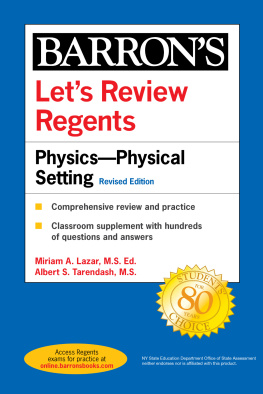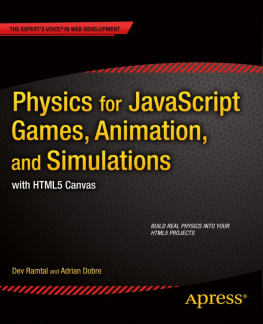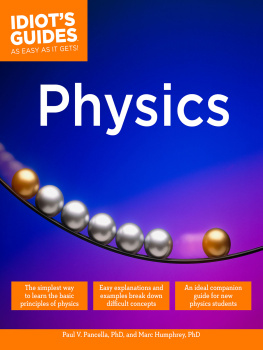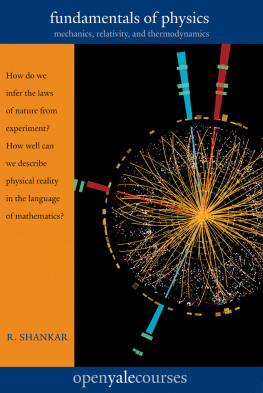F OUNDATIONS
OF
P HYSICS
LICENSE, DISCLAIMER OF LIABILITY, AND LIMITED WARRANTY
By purchasing or using this book (the Work), you agree that this license grants permission to use the contents contained herein, but does not give you the right of ownership to any of the textual content in the book or ownership to any of the information or products contained in it. This license does not permit uploading of the Work onto the Internet or on a network (of any kind) without the written consent of the Publisher. Duplication or dissemination of any text, code, simulations, images, etc. contained herein is limited to and subject to licensing terms for the respective products, and permission must be obtained from the Publisher or the owner of the content, etc., in order to reproduce or network any portion of the textual material (in any media) that is contained in the Work.
M ERCURY L EARNING AND I NFORMATION (MLI or the Publisher) and anyone involved in the creation, writing, or production of the companion disc, accompanying algorithms, code, or computer programs (the software), and any accompanying Web site or software of the Work, cannot and do not warrant the performance or results that might be obtained by using the contents of the Work. The author, developers, and the Publisher have used their best efforts to insure the accuracy and functionality of the textual material and/or programs contained in this package; we, however, make no warranty of any kind, express or implied, regarding the performance of these contents or programs. The Work is sold as is without warranty (except for defective materials used in manufacturing the book or due to faulty workmanship).
The author, developers, and the publisher of any accompanying content, and anyone involved in the composition, production, and manufacturing of this work will not be liable for damages of any kind arising out of the use of (or the inability to use) the algorithms, source code, computer programs, or textual material contained in this publication. This includes, but is not limited to, loss of revenue or profit, or other incidental, physical, or consequential damages arising out of the use of this Work.
The sole remedy in the event of a claim of any kind is expressly limited to replacement of the book, and only at the discretion of the Publisher. The use of implied warranty and certain exclusions vary from state to state, and might not apply to the purchaser of this product.
F OUNDATIONS
OF
P HYSICS
Steve Adams

Reprint and Revision Copyright 2019 by M ERCURY L EARNING AND I NFORMATION LLC. All rights reserved.
Original title and copyright: Principles of Physics. Copyright 2017 by The Pantaneto Press. All rights reserved. Published by The Pantaneto Press.
This publication, portions of it, or any accompanying software may not be reproduced in any way, stored in a retrieval system of any type, or transmitted by any means, media, electronic display or mechanical display, including, but not limited to, photocopy, recording, Internet postings, or scanning, without prior permission in writing from the publisher
Publisher: David Pallai
M ERCURY L EARNING AND I NFORMATION
22841 Quicksilver Drive
Dulles, VA 20166
info@merclearning.com
www.merclearning.com
(800) 232-0223
Steve Adams. Foundations of Physics.
ISBN: 9781683921448
The publisher recognizes and respects all marks used by companies, manufacturers, and developers as a means to distinguish their products. All brand names and product names mentioned in this book are trademarks or service marks of their respective companies. Any omission or misuse (of any kind) of service marks or trademarks, etc. is not an attempt to infringe on the property of others.
Library of Congress Control Number: 2019937248
192021321 This book is printed on acid-free paper in the United States of America.
Our titles are available for adoption, license, or bulk purchase by institutions, corporations, etc. For additional information, please contact the Customer Service Dept. at 800-232-0223(toll free).
All of our titles are available in digital format at authorcloudware.com and other digital vendors. The sole obligation of M ERCURY L EARNING AND I NFORMATION to the purchaser is to replace the book, based on defective materials or faulty workmanship, but not based on the operation or functionality of the product.
For Alison
The aim of this book is to draw on the essential physical principles that typical physics courses use to provide a strong conceptual base for the further study of more advanced topics. As such this book provides support for both introductory courses (calculus-based) and for readers interested in a basic review of key topics in physics. It will also be a useful reference work for instructors.
The focus is on physical principles. Applications are used to exemplify the physics but do not divert attention from the underlying concepts. Mathematics is the language of physics and a mathematical approach is taken throughout, drawing mathematical techniques including basic calculus. The approach here acknowledges this and helps to secure a foundation of relevant mathematical skills in the context of real physical problems.
Practical techniques, including the collection, presentation, analysis, and evaluation of data, are discussed in the context of key experiments linked to the theoretical spine of the work. There are also sections on testing mathematical relationships, the analysis of uncertainties, and how to approach, carry out, and write-up experimental investigations.
Every chapter concludes with a set of exercises and an appendix on Fermi problems provides an open-ended challenge that allows the reader to practice their skills in unfamiliar contexts.
How to use the book
Although the order of topics in this book mirrors that of most physics courses, it is not intended to be read in order or from cover to cover, and most chapters can be read in isolation. The book is there to be consulted, as and when a topic is studied or revised. The early sections on the language of physics and representing and analyzing data can be referred back to from any of the other sections. The appendices contain summary lists of units and useful data, equations, solutions to exercises, and a guide to planning, carrying out, and writing up experiments. There is also an extensive glossary of terms.
NASAs Mars climate orbiter was launched in 1998 and should have gone into orbit around Mars 286 days later. Instead it fell too close to the planet and broke up in the atmosphere. The mission had cost upwards of $100,000,000. Why did this happen? Because Lockheed Martin, who was calculating the thrust to maneuver the spacecraft, used English units (pound-seconds), while NASA, which controlled the thrusters, was expecting metric units (newton-seconds). Units matter!
The international system of units is based on seven base units:

The definition of each base unit is related to the experimental method that is used to establish the unit in the laboratory. All mechanical quantities can be expressed in terms of just three base unitslength, mass, and timeand the definitions of each of these is given below.

You will notice that the meter is actually defined in terms of the speed of light. This has been the case since 1983 when the speed of light, which had been measured with ever-increasing precision, was defined to have the value 299,792,458 ms1.
Next page











